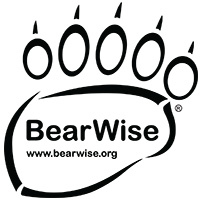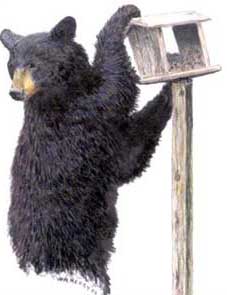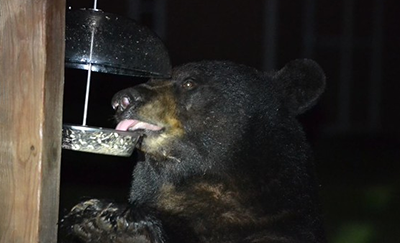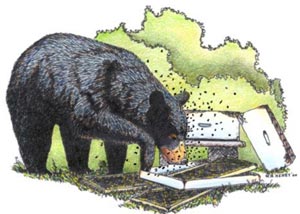Solving Bear Problems
People share in the responsibility to avoid conflicts with bears.
The best way to avoid bear problems is to take precautions to not attract them in the first place.

Bear Wise helps people live responsibly with black bears.
NEVER FEED BEARS – They will associate people with food and may become a persistent problem for you and your neighbors. It is illegal to feed bears in Maryland.
If you encounter a bear, remain calm.
DON’T PANIC. Leave the area.
If a problem occurs and continues, contact your local Maryland Wildlife and Heritage Service office listed at the bottom of this page.

Camping in Bear Country
To reduce the chance of experiencing bear problems:
- Move to another campsite if fresh bear signs are present.
-
NEVER keep food in your tent.
- Use canned and dried foods to minimize food odors.
- Store foods out of a bear’s reach, in a vehicle or enclosed building if possible.
- Use airtight or bear-proof containers.
- Rinse containers before disposal and recycle.
- Burn waste paper in your campfire.
- DO NOT BURN OR BURY FOOD SCRAPS!
- Remove all garbage and fish remains from camp EVERY EVENING.
- Keep pets on a leash.
-
If a bear comes into camp:
-
DON’T FEED IT! Scare it away.
- Make loud noises, bang pans, or yell.
- Do not allow it to engage with pets.
Seeing bears can be very enjoyable. However, having a bear in camp can lead to problems that will persist long after you have gone home. If a problem becomes serious, your safety and the bear’s safety may become jeopardized.
Bears may make aggressive sounds or possibly bluff charge when they bluff charges, it may stop after several yards or just a few feet short of the threat. Remember, if a bear exhibits these behaviors, it is telling you that
YOU ARE TOO CLOSE!
Spray repellents containing capsaicin (hot pepper liquid) are available to discourage bold bears. These repellents are effective and will not permanently damage the bear’s eyes or make the bear aggressive.
It is rare when a bear cannot be chased away. Remember to leave a clear escape route for the bear.
Garbage Cans and Dumpsters
Food odors and garbage may attract bears to establishments. To help reduce bear problems:
- Use bear-proof trash cans and dumpsters.
- Move cans or dumpsters away from areas used by people.
- Pick up garbage and fish remains promptly every evening.
- Wash cans and dumpsters frequently.
- Use lime to cut odors.
- A 10% ammonia solution may be used as a disinfectant and a bear deterrent.
Homes and Cabins
Trash and bird feeders are the most common attractants responsible for luring bears to human dwellings. Pet food, charcoal grills, fruit trees and gardens may also attract bears. Once a bear finds food around your home it will likely return.
To minimize bear problems on your property:
- Reduce garbage odors. Rinse food cans and wrappers before disposal.
- Compost vegetable scraps properly away from house.
- Keep meat scraps in the freezer until garbage pickup day.
- Wash garbage cans regularly and use lime to cut odors.
- Keep garbage cans in a bear-proof container or in an enclosed building until trash pickup.
See links to bear-proof cans above.
- Remove bird feeders in the spring. If you persist in feeding during summer, remove seed, suet and hummingbird feeders at night.
- Keep pet food inside.
- Keep barbecue grills and picnic tables clean.
- Use an energized fence to keep bears out of beehives, sweet corn, fruit trees and berry patches. (An energized fence is powered by a low-impedance, high –voltage energizer that provides a short-duration, high-energy impulse.)
- Barking dogs, bright lights and noisemakers will sometimes discourage bears from coming into an area.

Black bear at a bird feeder by Ranger Sarah Milbourne
If a bear comes into your yard, DON’T PANIC! DON’T SHOOT! DON’T APPROACH IT!
- Back away slowly.
- Go inside and wait for the bear to leave.
- Most bears fear people and will leave when they see you.
- If a bear woofs, snaps its jaws, slaps the ground or brush, or bluff charges:
YOU ARE TOO CLOSE!
- Learn to tolerate bears. Many bears are killed or injured when not causing problems.
If a bear refuses to leave:
- Be sure you have allowed the bear an escape route.
- Make loud noises to scare it away.
If a bear is treed:
-
LEAVE IT ALONE! The bear will usually go away when it feels safe.
- Have people leave the area.
- Remove your dog from the area.
These precautions will help reduce bear problems.
Agriculture and Livestock
Landowners sometimes experience bear problems with beehives, standing crops, orchards, and livestock.
To control problems:
- Corral animals close to buildings at night.
- Promptly bury dead animals or take them to a rendering plant.
- Eliminate on-farm garbage dumps.
- Monitor crops to detect problems early.
- Consider electric fencing as a preventive measure.
Bears will eat standing corn and can severely damage fruit trees. Bears rarely prey on livestock, but on occasion, sheep, swine, and poultry have been taken. Bears are often blamed unnecessarily for predation because they are observed feeding on dead animals. However, these animals typically have died from other causes (stillborn calves, for example).
Because of the potential for large financial losses, bears are especially troublesome in orchards and beehives. Energized fences are the best long-term control measure for these situations. These fencing systems will prevent wildlife damage when installed and maintained properly. If damage occurs, immediately contact your local office of DNR’s Wildlife & Heritage Service for technical recommendations.
Beehives
Beehives contain the perfect bear food - honey and larvae.
To a bear, there is little difference between a beehive and a hollow tree, except that a hive is probably easier to crack open.

Learn More about Black Bears and Bee Keeping
The Black Bear Conservation Stamp Program began in 1996. Authorized by the Maryland General Assembly, the stamp generates funds that are used to compensate farmers who have reported damage to agricultural crops caused by black bears.
Strategies for Minimizing Bear/Human Conflicts
Bears can easily become used to human activities. This occurs especially when bears learn to associate people with food. Unfortunately, this can lead to a bear losing its natural fear of people. Bears are intelligent, opportunistic feeders. They will return to places where they have found an easy meal. Human habituated bears can create situations that are dangerous for both humans and bears.
The DNR-Wildlife & Heritage Service has implemented several strategies to meet the demand of Maryland’s growing black bear population.
- A wildlife response team is on call 24 hours a day seven days a week to respond to emergencies. DNR staff also provides aversive conditioning.
- A comprehensive outreach and education plan is in effect to educate Marylanders and visitors about living with black bears.
- The
Black Bear Damage Reimbursement Fund compensates landowners who have suffered agricultural damage as a result of black bears.
- Wildlife & Heritage Service staff provide technical assistance to landowners who are experiencing bear problems.
- Wildlife & Heritage Service will provide electric fencing and technical support for beekeepers experiencing problems with bears around beehives.
Aversive conditioning is a tool used by DNR to change bear behavior. It provides negative feedback to problem bears. The unpleasant experience discourages individual bears from repeating undesirable behavior.
Aversive conditioning may include one or more of the following actions applied by trained DNR staff.
- Chemical irritant (capsaicin spray) applied at close range to the face of the bear.
- The use of noise making pyrotechnics (screamers, explosive scare shells, rockets) fired in the direction of the bear.
- Non-lethal rubber projectiles fired from a shotgun at the rump or shoulder of the bear.
For More Information
To Report Bear Related Emergencies Call 1-410-260-8888
If you have persistent bear problems or want more information on bears, contact your local DNR Wildlife & Heritage Service office or one of the offices listed below.
Maryland Department of Natural Resources
Wildlife & Heritage Service
Tawes State Office Building
580 Taylor Avenue
Annapolis, MD 21401
Telephone: 410-260-8540
Toll Free in Maryland: 1-877-620-8DNR, Ext. 8540
TDD: 410-974-3683
Wildlife Service Offices – Western Maryland
Garrett County
Mt. Nebo Wildlife Management Area
1728 Kings Run Road
Oakland, MD 21550
301-334-4255
Western Regional Office (Allegany County)
12512 N.E. Pleasant Valley Rd
Cumberland, MD 21502
301-777-2136
Washington & Frederick Counties
Indian Springs Wildlife Management Area
14038 Blairs Valley Road
Clear Spring, MD 21722
301-842-2702
Wildlife Service Office – Central Region
(Baltimore, Carroll, Cecil, Howard, Harford and Montgomery counties and Baltimore City)
Central Region Main Office
3740 Gwynnbrook Ave.
Owings Mills, MD 21117
410-356-0941
Illustrations by Wade Henry